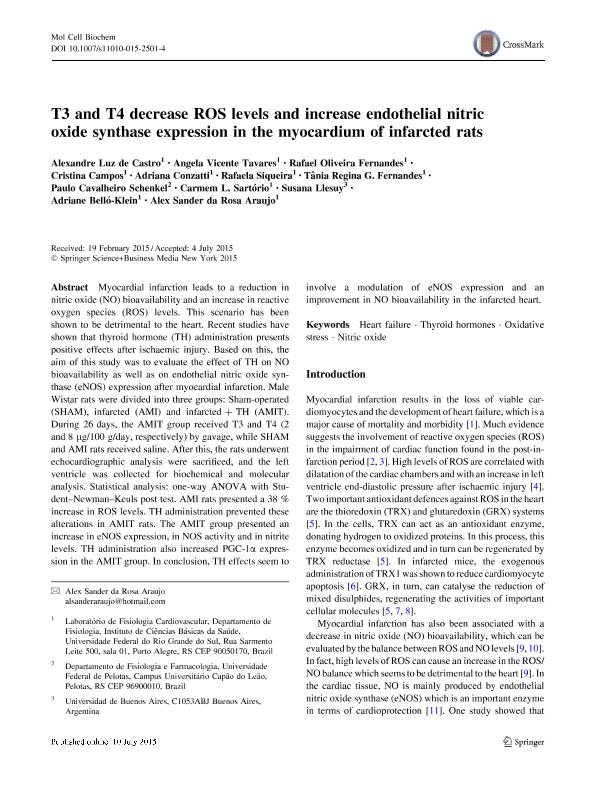Mostrar el registro sencillo del ítem
dc.contributor.author
de Castro, Alexandre Luz
dc.contributor.author
Tavares, Angela Vicente
dc.contributor.author
Fernandes, Rafael Oliveira
dc.contributor.author
Campos, Cristina
dc.contributor.author
Conzatti, Adriana
dc.contributor.author
Siqueira, Rafaela
dc.contributor.author
Fernandes, Tânia Regina G.
dc.contributor.author
Schenkel, Paulo Cavalheiro
dc.contributor.author
Sartório, Carmem L.
dc.contributor.author
Llesuy, Susana Francisca

dc.contributor.author
Belló Klein, Adriane
dc.contributor.author
da Rosa Araujo, Alex Sander
dc.date.available
2018-03-15T18:19:28Z
dc.date.issued
2015-10
dc.identifier.citation
de Castro, Alexandre Luz; Tavares, Angela Vicente; Fernandes, Rafael Oliveira; Campos, Cristina; Conzatti, Adriana; et al.; T3 and T4 decrease ROS levels and increase endothelial nitric oxide synthase expression in the myocardium of infarcted rats; Springer; Molecular and Cellular Biochemistry; 408; 1-2; 10-2015; 235-243
dc.identifier.issn
0300-8177
dc.identifier.uri
http://hdl.handle.net/11336/38961
dc.description.abstract
Myocardial infarction leads to a reduction in nitric oxide (NO) bioavailability and an increase in reactive oxygen species (ROS) levels. This scenario has been shown to be detrimental to the heart. Recent studies have shown that thyroid hormone (TH) administration presents positive effects after ischaemic injury. Based on this, the aim of this study was to evaluate the effect of TH on NO bioavailability as well as on endothelial nitric oxide synthase (eNOS) expression after myocardial infarction. Male Wistar rats were divided into three groups: Sham-operated (SHAM), infarcted (AMI) and infarcted + TH (AMIT). During 26 days, the AMIT group received T3 and T4 (2 and 8 µg/100 g/day, respectively) by gavage, while SHAM and AMI rats received saline. After this, the rats underwent echocardiographic analysis were sacrificed, and the left ventricle was collected for biochemical and molecular analysis. Statistical analysis: one-way ANOVA with Student–Newman–Keuls post test. AMI rats presented a 38 % increase in ROS levels. TH administration prevented these alterations in AMIT rats. The AMIT group presented an increase in eNOS expression, in NOS activity and in nitrite levels. TH administration also increased PGC-1α expression in the AMIT group. In conclusion, TH effects seem to involve a modulation of eNOS expression and an improvement in NO bioavailability in the infarcted heart.
dc.format
application/pdf
dc.language.iso
eng
dc.publisher
Springer

dc.rights
info:eu-repo/semantics/openAccess
dc.rights.uri
https://creativecommons.org/licenses/by-nc-sa/2.5/ar/
dc.subject
Heart Failure
dc.subject
Nitric Oxide
dc.subject
Oxidative Stress
dc.subject
Thyroid Hormones
dc.subject.classification
Otras Ciencias Biológicas

dc.subject.classification
Ciencias Biológicas

dc.subject.classification
CIENCIAS NATURALES Y EXACTAS

dc.title
T3 and T4 decrease ROS levels and increase endothelial nitric oxide synthase expression in the myocardium of infarcted rats
dc.type
info:eu-repo/semantics/article
dc.type
info:ar-repo/semantics/artículo
dc.type
info:eu-repo/semantics/publishedVersion
dc.date.updated
2018-03-13T13:55:17Z
dc.journal.volume
408
dc.journal.number
1-2
dc.journal.pagination
235-243
dc.journal.pais
Alemania

dc.journal.ciudad
Berlín
dc.description.fil
Fil: de Castro, Alexandre Luz. Universidade Federal do Rio Grande do Sul; Brasil
dc.description.fil
Fil: Tavares, Angela Vicente. Universidade Federal do Rio Grande do Sul; Brasil
dc.description.fil
Fil: Fernandes, Rafael Oliveira. Universidade Federal do Rio Grande do Sul; Brasil
dc.description.fil
Fil: Campos, Cristina. Universidade Federal do Rio Grande do Sul; Brasil
dc.description.fil
Fil: Conzatti, Adriana. Universidade Federal do Rio Grande do Sul; Brasil
dc.description.fil
Fil: Siqueira, Rafaela. Universidade Federal do Rio Grande do Sul; Brasil
dc.description.fil
Fil: Fernandes, Tânia Regina G.. Universidade Federal do Rio Grande do Sul; Brasil
dc.description.fil
Fil: Schenkel, Paulo Cavalheiro. Universidade Federal de Pelotas; Brasil
dc.description.fil
Fil: Sartório, Carmem L.. Universidade Federal do Rio Grande do Sul; Brasil
dc.description.fil
Fil: Llesuy, Susana Francisca. Universidad de Buenos Aires; Argentina. Consejo Nacional de Investigaciones Científicas y Técnicas. Oficina de Coordinación Administrativa Houssay. Instituto de Bioquímica y Medicina Molecular. Universidad de Buenos Aires. Facultad de Farmacia y Bioquímica. Instituto de Bioquímica y Medicina Molecular; Argentina
dc.description.fil
Fil: Belló Klein, Adriane. Universidade Federal do Rio Grande do Sul; Brasil
dc.description.fil
Fil: da Rosa Araujo, Alex Sander. Universidade Federal do Rio Grande do Sul; Brasil
dc.journal.title
Molecular and Cellular Biochemistry

dc.relation.alternativeid
info:eu-repo/semantics/altIdentifier/doi/http://dx.doi.org/10.1007/s11010-015-2501-4
dc.relation.alternativeid
info:eu-repo/semantics/altIdentifier/url/https://link.springer.com/article/10.1007%2Fs11010-015-2501-4
Archivos asociados
